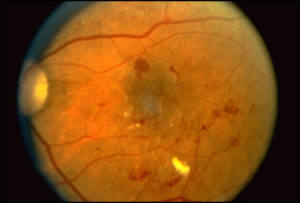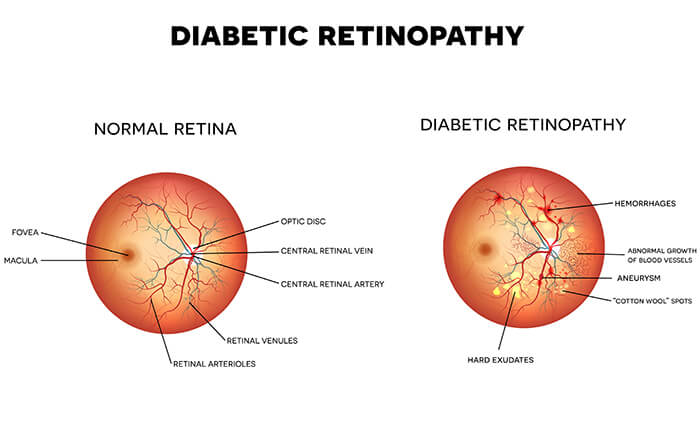
Living with diabetes can be challenging for many people because diabetes causes many other issues. When you learn that you have diabetes it might just be a step towards living better, but when it comes to your eyes you should make sure you have regular eye examinations to prevent any potential problems. Diabetic eye diseases can cause serious damage to your eyes.
What is diabetic retinopathy?
Diabetic retinopathy is the most common diabetic eye disease and a leading cause of blindness in American adults. In the majority of diabetic retinopathy cases, blindness is completely preventable. Patients will need to work closely with their Maine Eye Center diabetic retina eye doctors to contain this disease. The use of medications and daily blood sugar monitoring can make a major impact on containing the worsening of diabetic retinopathy.
The retina is the like the film in a camera; in which it is the light sensing film on the back of the eye that captures the images. In the diabetes disease, sugar (glucose) builds up within blood vessels in the retina and tissues of the body causing glucose to attach to the proteins in the wall. This alters their normal structure and functioning. The vessels eventually get blocked and leak fluid. When they cannot deliver an adequate amount of blood supply to the eye, the eye can generate abnormal new blood vessels. Early diabetic retinopathy usually has no symptoms. However, worsening diabetic retinopathy can lead to visual loss and blindness.

The stages of diabetic retinopathy are divided into two categories, nonproliferative retinopathy and proliferative retinopathy.
Nonproliferative Retinopathy
This is the first and earliest stage of diabetic retinopathy. NPDR occurs when the small blood vessels of the retina start to leak fluid or bleed. This activity will lead to the formation of deposits called exudates. Once these blood vessels start to leak swelling within the central part of the retina occurs. When the leakage of these blood vessels causes swelling macular edema sets in and the blood vessels can become blocked. This stage of diabetic retinopathy is common when a person develops diabetes.
Proliferative Retinopathy
When these new vessels start to grow, this marks the beginning of the next stage of diabetic retinopathy, proliferative diabetic retinopathy. This level of diabetic retinopathy is the most severe and dangerous for the diabetic patient. These new blood vessels can grow on the retina, optic nerve, iris or into the vitreous gel inside the eye, and tend to grow poorly and are very fragile. The damage that these blood vessels bring to retina can be catastrophic and include hemorrhages on the retina, scar tissues build up, and possible retina detachment.
Diabetic Retinopathy Symptoms
- If you are a diabetic patient it is suggested by Maine Eye Center that you have regular eye exams to look for symptoms. Diabetic retinopathy does not really have any initial warning signs.
- Retinal swelling may cause blurred vision and distortion.
- Objects may look smaller or larger than normal
- Floaters may appear due to the bleeding of the blood vessels.
*If proliferative diabetic retinopathy is left untreated blindness can occur. The best alternative to fighting PDR is early detection so that you and your eye doctor can begin to control this development.
Diabetic retinopathy treatments:
- laser treatments – These laser treatments are also known as photocoagulation and is used to stop or slow the leakage of blood and fluid in the eye.
- intraocular corticosteroids – Many studies have been conducted recently with these types of injections. They may reduce retinal swelling and improve visual acuity in patients with diabetic macular edema.
- vitrectomy – A vitrectomy may be performed to clear blood and debris from the eye, to remove scar tissue, or to alleviate traction on the retina.
Learning to live with diabetes and diabetic retinopathy
If you are a diabetic patient you have most likely had some kind of discussion with your primary care doctor regarding diet. The nutrition of the food you eat becomes critical for maintaining proper blood sugar levels. Please refer to this list below for diabetic nutrition tips:
- Reduce saturated fats and avoid trans fats
- Include vegetables in your diet
- Increase fiber intake
- Reduce caffeine and refined sugar
